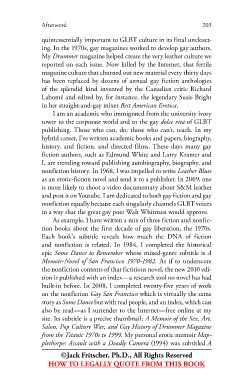Page 215 - Corporal in Charge of Taking Care of Captain O'Malley
P. 215
Afterword 203
quintessentially important to GLBT culture in its final uncloset-
ing. In the 1970s, gay magazines worked to develop gay authors.
My Drummer magazine helped create the very leather culture we
reported on each issue. Now killed by the Internet, that fertile
magazine culture that churned out new material every thirty days
has been replaced by dozens of annual gay fiction anthologies
of the splendid kind invented by the Canadian critic Richard
Labonté and edited by, for instance, the legendary Susie Bright
in her straight-and-gay mixer Best American Erotica.
I am an academic who immigrated from the university ivory
tower to the corporate world and to the gay dolce vita of GLBT
publishing. Those who can, do; those who can’t, teach. In my
hybrid career, I’ve written academic books and papers, biography,
history, and fiction, and directed films. These days many gay
fiction authors, such as Edmund White and Larry Kramer and
I, are trending toward publishing autobiography, biography, and
nonfiction history. In 1968, I was impelled to write Leather Blues
as an erotic-fiction novel and send it to a publisher. In 2009, one
is more likely to shoot a video documentary about S&M leather
and post it on Youtube. I am dedicated to both gay fiction and gay
nonfiction equally because each singularly channels GLBT voices
in a way that the great gay poet Walt Whitman would approve.
As example, I have written a mix of three fiction and nonfic-
tion books about the first decade of gay liberation, the 1970s.
Each book’s subtitle reveals how much the DNA of fiction
and nonfiction is related. In 1984, I completed the historical
epic Some Dance to Remember whose mixed-genre subtitle is A
Memoir-Novel of San Francisco 1970-1982. As if to underscore
the nonfiction contents of that fictitious novel, the new 2010 edi-
tion is published with an index—a research tool no novel has had
built-in before. In 2008, I completed twenty-five years of work
on the nonfiction Gay San Francisco which is virtually the same
story as Some Dance but with real people, and an index, which can
also be read—as I surrender to the Internet—free online at my
site. Its subtitle is a precise thumbnail: A Memoir of the Sex, Art,
Salon, Pop Culture War, and Gay History of Drummer Magazine
from the Titanic 1970s to 1999. My personal erotic memoir Map-
plethorpe: Assault with a Deadly Camera (1994) was subtitled A
©Jack Fritscher, Ph.D., All Rights Reserved
HOW TO LEGALLY QUOTE FROM THIS BOOK

